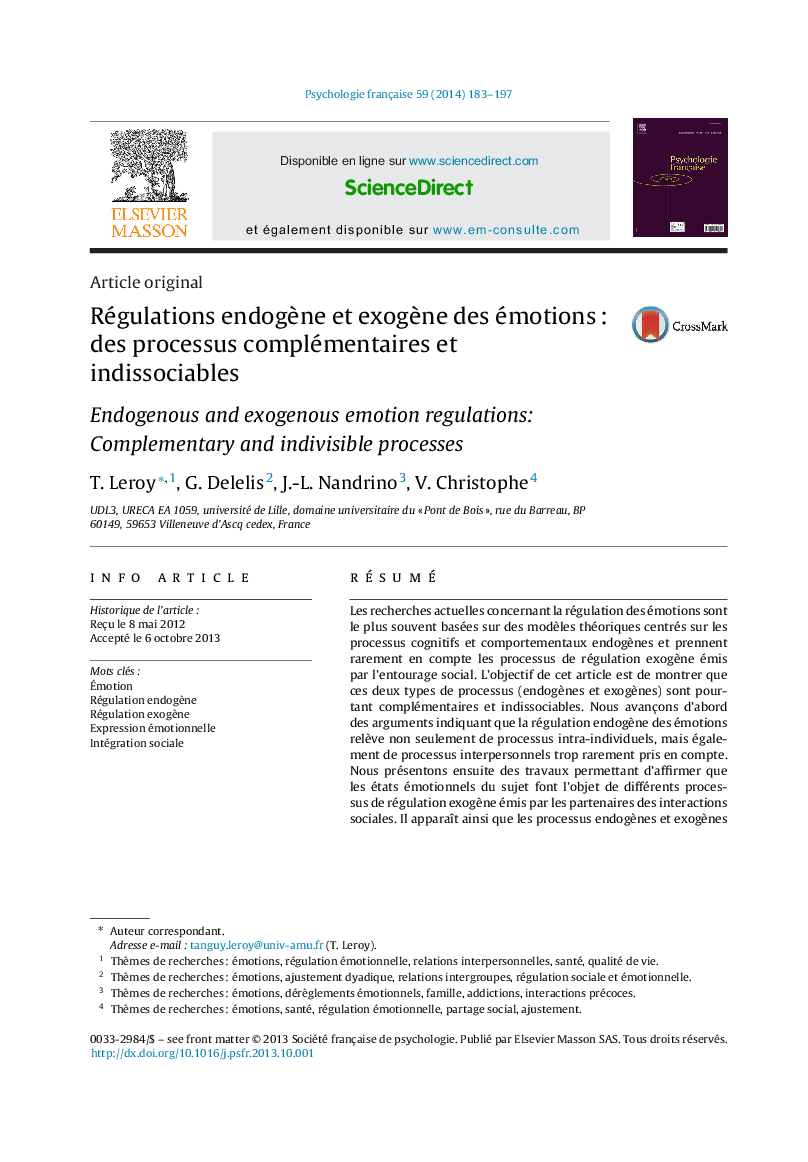| کد مقاله | کد نشریه | سال انتشار | مقاله انگلیسی | نسخه تمام متن |
|---|---|---|---|---|
| 335721 | 547017 | 2014 | 15 صفحه PDF | دانلود رایگان |

RésuméLes recherches actuelles concernant la régulation des émotions sont le plus souvent basées sur des modèles théoriques centrés sur les processus cognitifs et comportementaux endogènes et prennent rarement en compte les processus de régulation exogène émis par l’entourage social. L’objectif de cet article est de montrer que ces deux types de processus (endogènes et exogènes) sont pourtant complémentaires et indissociables. Nous avançons d’abord des arguments indiquant que la régulation endogène des émotions relève non seulement de processus intra-individuels, mais également de processus interpersonnels trop rarement pris en compte. Nous présentons ensuite des travaux permettant d’affirmer que les états émotionnels du sujet font l’objet de différents processus de régulation exogène émis par les partenaires des interactions sociales. Il apparaît ainsi que les processus endogènes et exogènes interagissent et se complètent mutuellement pour favoriser à la fois l’adaptation aux situations émotionnelles et l’intégration au réseau social.
Studies dealing with emotion regulation have known a fast expansion during the last twenty years. Yet, they are most often based on models centered on endogenous cognitive and behavioral processes as well as the pursuit of welfare, and do not consider the social aspect of emotions and emotion expression which elicit exogenous emotion regulation processes from social interaction partners. The goal of this article is to show that both endogenous and exogenous emotion regulation processes are complementary and indivisible, and to suggest working hypotheses about how they connect. In the first part of this document, after a quick reminder of the different theoretical approaches of (individual) endogenous emotion regulation, we emphasize works about social approach behaviors (social affiliation) in emotional situations. These studies report that social interactions are sometimes sought as they would allow for the endogenous implementation of interpersonal emotion regulation strategies, especially by means of emotion expression. Individual and interpersonal endogenous emotion regulation processes would then complementarily modify the emotions experienced by an individual faced with a critical situation. The second part of this article underlines that social interaction partners actually are operators of exogenous emotion regulation processes rather than passive reservoirs of resources an individual may pick up to regulate their emotions. For that purpose, we especially consider the ways relatives (directly or indirectly, explicitly or implicitly) constrain the social affiliation behaviors and emotion expressions of an individual who experiences emotions. Thus, we argue that those behaviors are strongly influenced not only by the nature and intensity of emotions, but also by: firstly, social learning about how to feel, what to express and how to regulate emotions in a specific situation; secondly, features of the social environment as well as social expectations and demands about sharing emotions versus inhibiting their expression; and thirdly, the exogenous emotion regulation strategies a partner may use to regulate an individual's emotions. This set of studies entices us to consider endogenous and exogenous emotion regulation processes as acting jointly to promote not only the adaptation to emotional situations, but also the quality of social bonds between members of a social network. Social integration is thus central in the study of emotion regulation processes.
Journal: Psychologie Française - Volume 59, Issue 3, September 2014, Pages 183–197